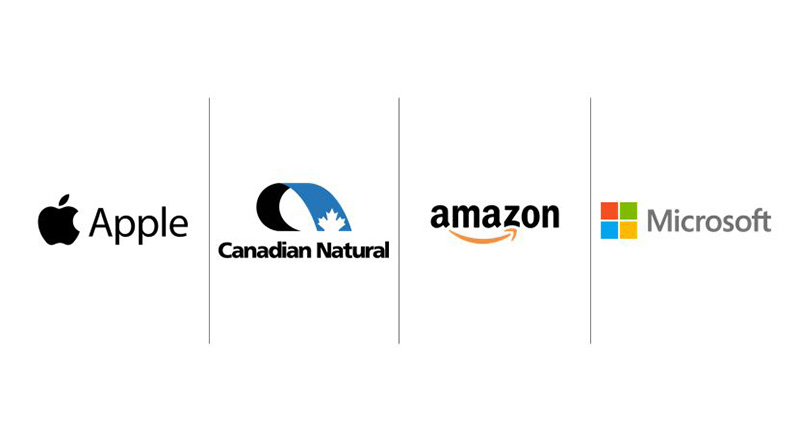Company Updates: Microsoft, Apple, Amazon, and Canadian Natural Resources
Written by Christopher De Sousa, CIM® | Associate Portfolio Manager | www.marnoa.ca
Canadian Natural Resources
Canadian Natural Resources (CNQ) is a crude oil and natural gas exploration, development, and production company, with operations in Western Canada, the U.K. portion of the North Sea and Offshore Africa.
CNQ achieved record quarterly oil and natural gas production in Q4 and record production in 2023. Annual production in 2024 is now estimated to range between 1.33-1.38 million barrels of oil equivalent per day, an increase of ~2% from 2023 levels. Operating costs continue to moderate across the business resulting in a high degree of operating leveraging. CNQ is executing very well from a cash flow point of view. In 2023, free cash flow was $6.9 billion after dividend payments and capital spending.
CNQ achieved its $10 billion net debt level and will now target to allocate 100% of free cash flow (after growth capital and M&A) to shareholders through dividends and share buybacks. This capital program is expected to build momentum in the second half of this year as the Trans Mountain Expansion (TMX) project is targeting to be in service in the second quarter of 2024. CNQ has committed to shipping 94,000 barrels per day for 20 years on Trans Mountain—an additional stream of revenue and cash flow.
CNQ has a significant reserves base underpinned by a low-cost structure. Total proved plus probable reserves have a life index of 43 years. What this means is CNQ has enough oil reserves that can last over 40 years if the company maintains its current production rate and if there were no additions to reserves. Furthermore, CNQ has one of the lowest WTI breakeven prices among industry peers in the mid-30s per barrel (vs. industry average >$50 per barrel). The combination of a significant reserve base and a low operating cost structure has helped CNQ deliver superior returns over the years.
Subsequent to quarter-end, CNQ announced a 5% increase to its dividend and plans to split the company’s shares on a two to one basis.
Microsoft
Microsoft continues to outperform and deliver outstanding results. Revenue and earnings were up 18% and 33%, respectively, for the quarter ending Dec 31. Microsoft's revenue from its Azure cloud platform rose 30% as the company integrates AI technologies across every layer of the company’s tech stack.
Azure is rapidly gaining market share in the cloud services market. This is evidenced by the growing number of customers migrating workloads to the Azure platform. Microsoft is securing more substantial and strategic contracts for Azure, with a growing number of new and existing customers making Azure commitments exceeding a billion dollars. Azure AI currently serves 53,000 customers, with one-third of them having joined Azure for the first time in the past year.
Microsoft is in the very early days of monetizing AI across its Azure and Office platforms. The early adoption and monetization of Microsoft 365 Copilot, in particular in the commercial market, has been promising to Azure’s growth and conversions from Office 365. There is strong enterprise demand for AI-related workloads and services. We expect demand to remain elevated and drive better-than-expected growth in long-term Azure contracts.
AI represents a new technology category that holds significant earnings potential for Microsoft, but it will require time for enterprise customers to fully utilize this technology on a large scale as many are still in the process of modernizing their tech stacks with new cloud computing infrastructures.
In our view, Microsoft is well-positioned to deliver double-digit sales and earnings growth through the next five years as it gains market share and benefits from a multi-year AI investment cycle.
Apple
Apple reported revenue and earnings growth of 2% and 16%, respectively, for the quarter ending Dec 31. Sales were driven by strength across iPhones (+6%) and services (+11%). The higher margin services business set record sales in advertising, cloud services, and payments. Paid subscriptions (e.g., Apple TV+, iCloud+, Apple Music, etc.) exceeded 1 billion and continues to grow in the double digits. Apple’s installed base of active devices is over 2.2 billion, which establishes a strong foundation for the future expansion of the services business.
The subject of generative AI has been gaining considerable attention lately. Interestingly, Apple is rarely brought up in these conversations. We think Apple is an underappreciated AI beneficiary that could benefit from integrating large language models (i.e., deep learning algorithms and large data sets used to understand and generate new content) into their technologies. Apple expects to reveal and discuss their generative AI products later this year. Like Microsoft, we believe Apple could integrate AI around their ecosystem to add more functionality and use-cases to their products, especially the iPhone.
The ability to run AI-enabled prompts on new AI-enhanced iPhones could potentially shorten the replacement cycle (currently ~40 months) as users upgrade to the new device. The last two iPhone “super cycles” occurred in 2014 when Apple first introduced the iPhone with a larger screen, and in 2020 when Apple introduced the first iPhone with 5G connectivity. The next cycle could be driven by AI in our view.
Apple has traditionally been a consumer-focused company, but now with the company’s latest innovation, the Vision Pro, we see the company making inroads into the enterprise market. Vision Pro is Apple’s first new product category since it launched the Apple Watch in 2015. We see a substantial opportunity for Vision Pro, and spatial computing as a whole, in various industries such as manufacturing, health care, and entertainment. While still in its infancy, immersive technologies like Vision Pro could revolutionize our entertainment experiences (e.g., sitting courtside at a basketball game) and the way we communicate and collaborate at work.
There are a number of interesting developments at Apple that could unlock upside to sales and earnings which we will be monitoring closely.
Amazon
In the latest quarter, Amazon reported strong revenue acceleration across retail, AWS, and advertising and record-high operating profits (and the second highest operating margins). All in all, Amazon had a great year, with net sales rising 12% to $574.8 billion and operating profits growing 3x to $36.9 billion in 2023.
Retail: Amazon is delivering orders to customers much quicker and at a lower cost. In 2023, Amazon reduced its cost to serve on a per-unit basis globally for the first time since 2018. Amazon has been overhauling its logistics network to regionalize its fulfillment to reduce delivery costs while maintaining fast shipping speeds. As a result, operating profit margins for Amazon’s North American retail business rose to 6.1%, just shy of its pre-pandemic record high of 6.4% in Q1 2019.
Ads: Amazon’s ad business is re-accelerating, growing 26% in Q4 (vs. 22% in Q2 and 25% in Q3). The growth was primarily driven by the launch of Prime Video sponsored ads, which is a new stream of high-margin incremental revenue. The advertising business is on the cusp of reaching a $50 billion annual revenue run-rate (growing at a rate of mid-20%). In 2024, we expect Amazon’s Prime Video ad inventory to attractive global advertisers, especially as AI tools enhance targeting and audience segmentation.
AWS: Amazon’s AWS cloud division has seen a quarter-to-quarter acceleration, with a growth rate of 13% compared to 12% in Q3, and an operating profit margin of approximately 30%. AWS is nearing an annualized revenue run rate of $100 billion. Current customers are renewing their AWS cloud contracts with increased commitments over longer periods. Similar to Microsoft, the backlog at AWS indicates a growing trend of customers transitioning and introducing new workloads to the cloud. Amazon projects that the annual recurring revenue related to generative AI will escalate to “tens of billions of dollars” in the coming years.
We expect the accelerating trends across Amazon’s major segments to continue through 2024.
Please click on the button below to subscribe to our mailing list.
By subscribing, you will get regular commentary about our portfolio holdings, market outlook, financial planning, and events. You can withdraw from receiving emails at any time by unsubscribing.
Disclaimer
Information in this article is from sources believed to be reliable; however, we cannot represent that it is accurate or complete. It is provided as a general source of information and should not be considered personal investment advice or solicitation to buy or sell securities. The views are those of the author, Christopher De Sousa, and not necessarily those of Raymond James Ltd. Investors considering any investment should consult with their Investment Advisor to ensure that it is suitable for the investor’s circumstances and risk tolerance before making any investment decision. Raymond James Ltd. is a Member Canadian Investor Protection Fund.




